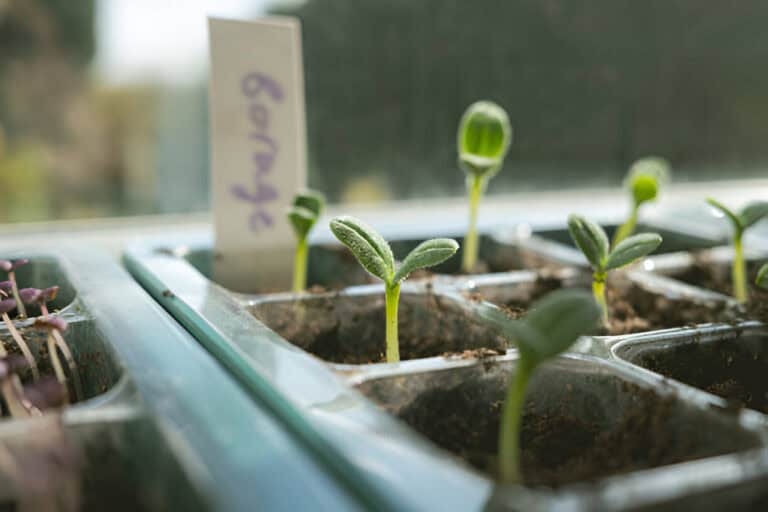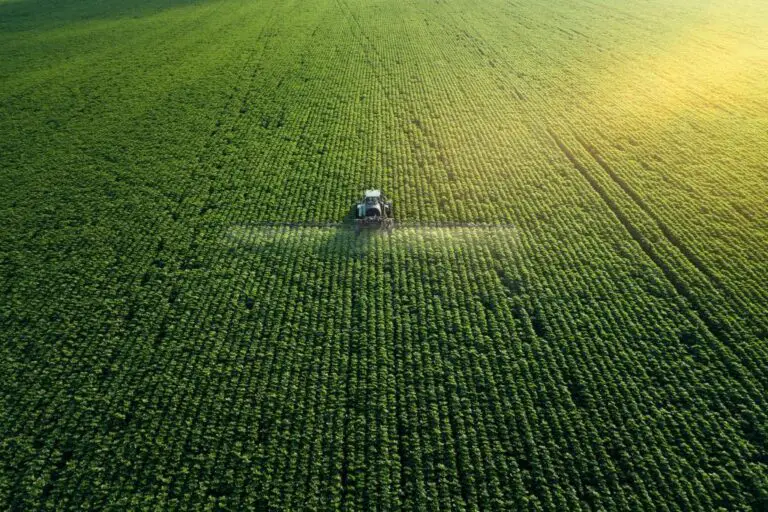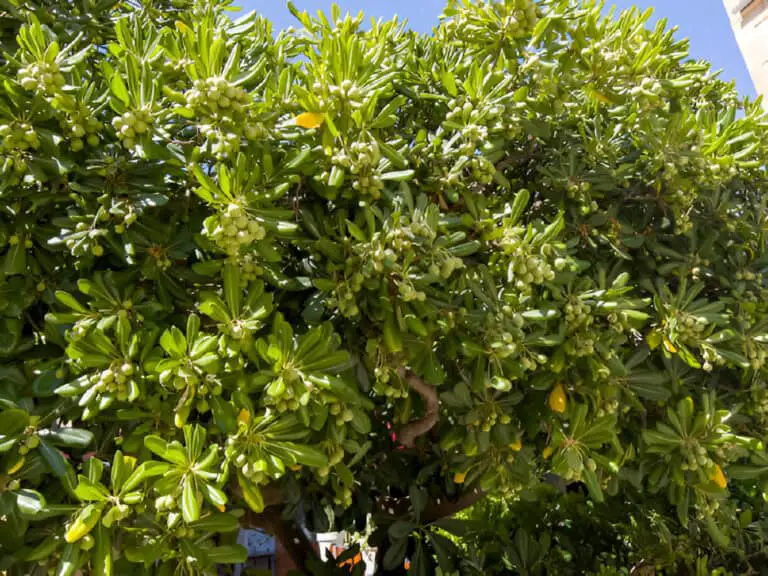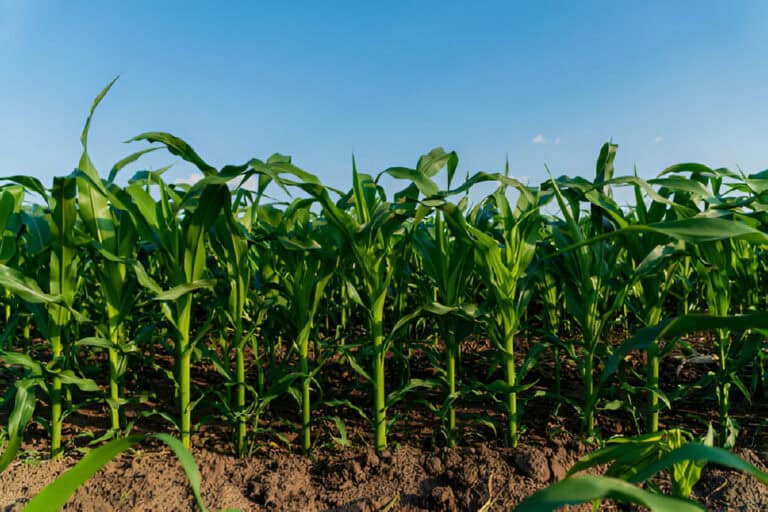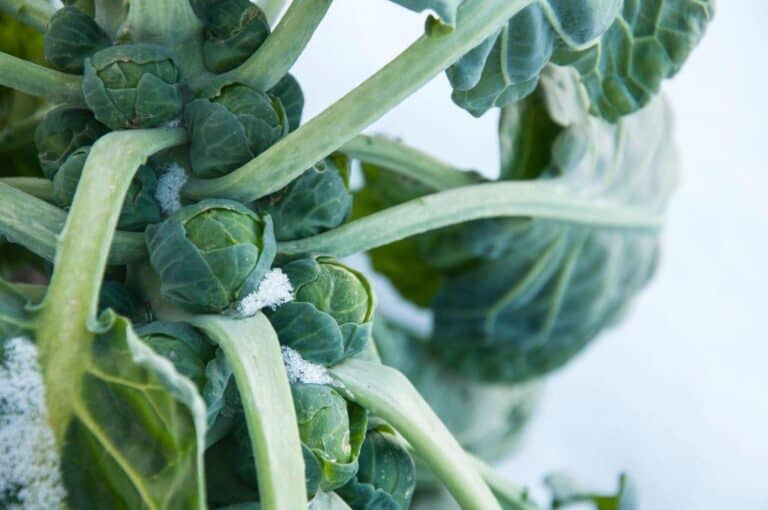Do Brussel Sprouts Need a Trellis and Support To Grow?
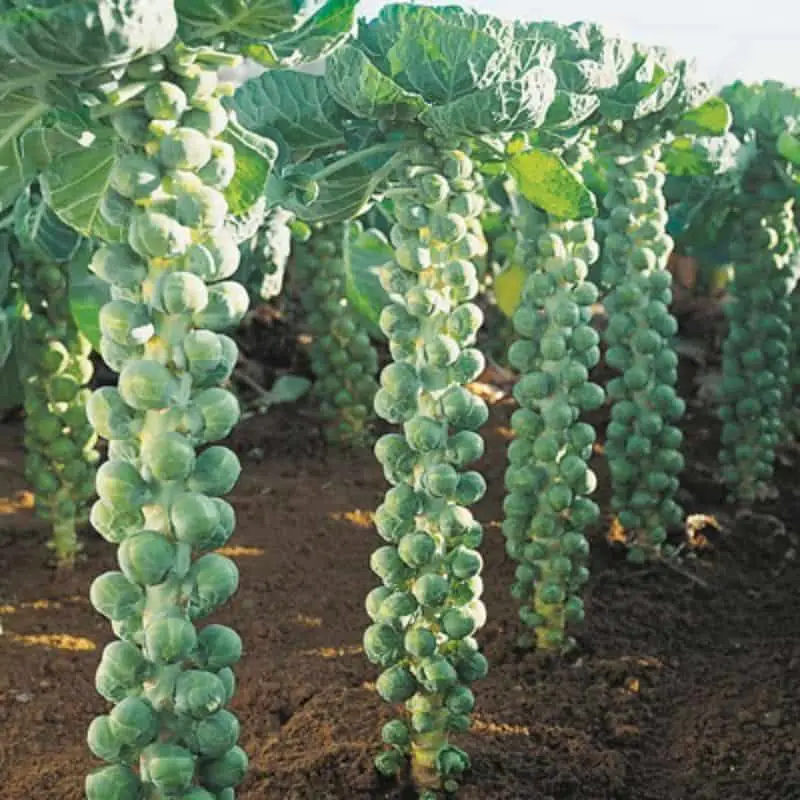
Are you considering growing Brussel sprouts in your garden? These petite, cabbage-like vegetables have gained popularity in recent years thanks to their health benefits and versatility in the kitchen. But here’s the burning question: do Brussel sprouts need a trellis and support to reach their full potential?
Well, let’s delve into the world of these delightful greens and find out. Picture this: sturdy stalks adorned with clusters of tender sprouts, slowly growing and maturing under your watchful eye. Brussel sprouts have their own unique growth habits. But when it comes to trellises and support, the answer isn’t a simple yes or no. Factors like wind exposure, limited space, and pest prevention come into play.
In this article, we’ll unravel the mystery, explore the growth habits of Brussel sprouts, and shed light on whether or not providing support is essential. Get ready to uncover the secrets to growing magnificent Brussel sprouts that will have your neighbors green with envy!
Overview of Brussels Sprouts
Brussels sprouts (Brassica oleracea var. gemmifera) are a cool-season vegetable that originated in Belgium, as their name suggests. These nutritious green gems are packed with vitamins, minerals, and fiber, making them a nutritious addition to your diet. When it comes to their growth habits, Brussels sprouts are fascinating plants that require specific conditions to thrive.
Brussel Sprouts Growth Habits
The natural growth habit of Brussels sprouts involves the formation of small cabbage-like heads along a central stalk. These sprouts develop in the leaf axils, the points where the leaves attach to the main stem.
As the plants mature, these sprouts gradually enlarge, resembling tiny cabbages. Factors such as temperature, spacing, and nutrient availability can influence the growth pattern of Brussels sprouts.
Brussel sprouts are cool-weather vegetables that thrive in temperatures ranging from 45°F to 75°F (7°C to 24°C). Brussel sprouts prefer well-drained, fertile soil with a pH level between 6.0 and 7.5. These plants require full sun exposure for a minimum of six hours a day, although they can tolerate partial shade.
When it comes to the growth habit of Brussel sprouts, they can reach a height of 2 to 3 feet (60 to 90 centimeters) with a spread of 1.5 to 2 feet (45 to 60 centimeters). The sprouts themselves grow in a spiral pattern along a thick central stalk, and they develop in the leaf axils of the plant. As the plants grow, the lower leaves will naturally yellow and fall off, leaving the sprouts exposed.
Do Brussel Sprouts Need Support?
Now, let’s address the main question: Do Brussel sprouts need a trellis and support to grow? The answer is both yes and no. While Brussel sprouts have sturdy stalks that can support their own weight, certain factors might make providing support beneficial.
Brussel sprouts have a natural growth habit that includes a sturdy central stalk that can generally support the weight of the plant and its developing sprouts. In ideal growing conditions, with ample sunlight, well-drained soil, and minimal wind exposure, Brussels sprouts may not require additional support.
However, there are several factors that can influence the need for providing support to Brussel sprout plants.
- Plant height and size: Some varieties of Brussel sprouts can reach impressive heights, often exceeding three feet. As Brussel sprouts grow taller, the weight of the sprouts can put strain on the central stalk, making it more susceptible to bending or breaking. In such cases, providing support can help maintain the plant’s upright position and prevent damage.
- Weather conditions and wind exposure: Brussel sprouts are susceptible to wind damage, especially when grown in areas with strong or gusty winds. Wind can sway the plants, causing them to bend or topple over. Providing support, such as stakes or cages, can help anchor the plants and protect them from wind-related damage.
- Soil fertility and health: Brussel sprouts thrive in well-drained, fertile soil. However, if the soil lacks essential nutrients or has poor structure, it can result in weaker plant growth and less sturdy stalks. In such cases, providing support can compensate for the weaker growth and help prevent the plants from toppling over.
- Sprout weight and maturity: As the Brussels sprouts mature and grow larger in size, their weight can strain the central stalk. This is particularly true during the later stages of growth, when the sprouts are fully developed. Supporting the plants can prevent the stalk from bending or breaking under the weight of the sprouts, ensuring the plant remains upright and healthy.
By evaluating these factors and assessing the specific conditions in your garden, you can determine whether providing support to your Brussels sprout plants is necessary. Observing the growth habit of the plants, monitoring weather conditions, and considering the overall health of the soil will help you make an informed decision.
In the following sections, we will explore different types of support structures, such as stakes and cages, and provide step-by-step instructions on how to stake or cage your Brussel sprout plants effectively. Whether you choose to provide support or not, ensuring the overall health and proper care of your Brussel sprouts will contribute to their successful growth and a bountiful harvest.
Benefits of Using a Trellis and Support for Brussels Sprouts
While Brussels sprouts can grow without support, providing them with a trellis or support system offers several benefits. Let’s take a closer look at why using a trellis is advantageous for growing Brussels sprouts:
- Improved air circulation and sunlight exposure: By training your Brussels sprouts to grow vertically on a trellis, you can enhance air circulation around the plants, reducing the risk of fungal diseases. Moreover, the increased exposure to sunlight promotes photosynthesis, leading to healthier and more productive plants.
- Increased accessibility for harvesting and pest management: When Brussels sprouts grow vertically, it becomes easier to harvest the sprouts as they are raised off the ground. This accessibility also facilitates pest management since you can more effectively monitor and control pests that may attack the plants.
Types of Support for Brussel Sprouts
Now that we’ve discussed the advantages of using a trellis for Brussels sprouts, let’s explore the various trellis designs and support options available:
| Trellis Type | Description |
| Vertical trellis | Consists of stakes or posts with horizontal wires or strings that Brussels sprouts can cling to. Provides sturdy support for the tall plants. |
| Cages | Wire cages made from materials like concrete reinforcing wire or chicken wire can be used to encircle Brussels sprouts, keeping them upright. |
| Stakes | Single stakes placed next to each plant, allowing you to tie the main stalk to the stake for support. Suitable for smaller gardens or containers. |
| Netting | Another option is to use netting to provide support for your Brussel sprouts. Drape the netting over the plants, allowing them to grow through the gaps. This method offers support and also helps deter birds from feasting on your sprouts. |
Steps To Trellising Brussels Sprouts
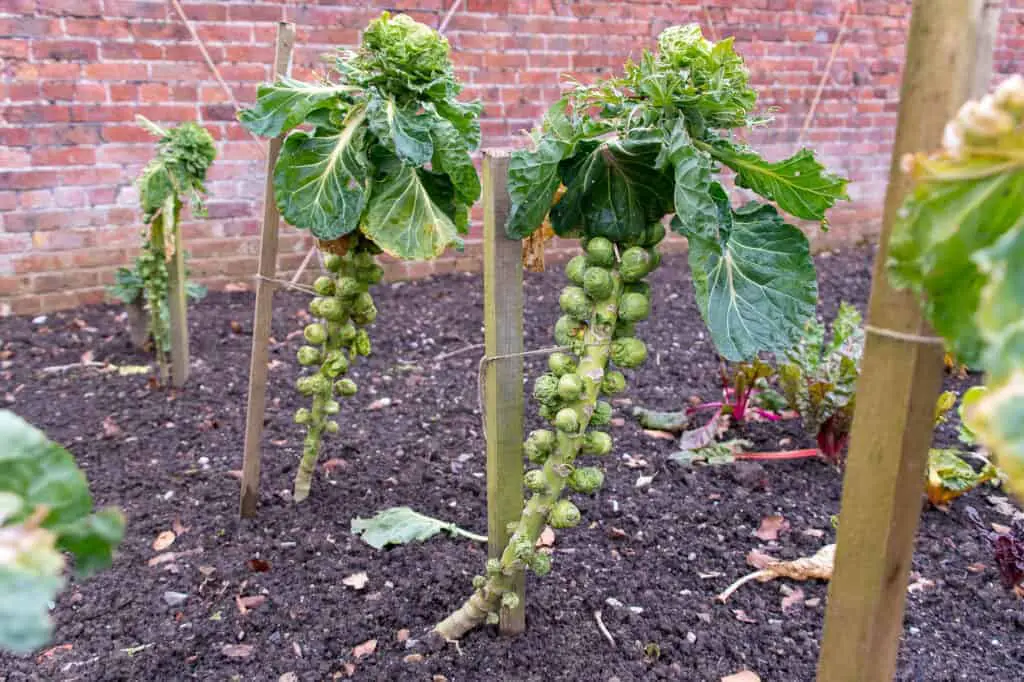
Trellising Brussels sprouts may seem intimidating, but with the right guidance, it can be a straightforward process. Follow these step-by-step instructions to set up a trellis system for your Brussels sprouts:
- Preparing the soil and planting Brussels sprouts:
- Choose a well-draining location with full sun or partial shade.
- Amend the soil with organic matter to improve fertility and drainage.
- Plant Brussels sprout seedlings or transplants at the appropriate spacing, typically 18-24 inches apart.
- Installing the trellis and providing initial support:
- Set up the trellis before planting to avoid damaging the young plants.
- Place the trellis structure securely in the ground, ensuring stability.
- If using a vertical trellis, attach horizontal wires or strings at regular intervals for the plants to cling to.
- If using cages, encircle each Brussels sprout plant with a cage and secure it in place.
- For stakes, insert them firmly next to each plant and tie the main stalk to the stake using soft plant ties or twine.
- Training the plants:
- As the Brussels sprouts grow, gently guide the main stalks towards the trellis or support structure.
- Tie the plants to the trellis or stakes using loose loops, allowing room for growth and flexibility.
- Regularly check the plants and adjust the ties as needed to prevent constriction.
- Maintenance and care:
- Water the plants deeply and consistently, keeping the soil evenly moist but not waterlogged.
- Apply a balanced fertilizer or compost around the base of the plants every few weeks to promote healthy growth.
- Mulch the soil to conserve moisture and suppress weed growth.
- Monitor the plants for pests and diseases, taking necessary measures for control.
- Harvesting and post-harvest handling:
- Harvest Brussels sprouts when the sprouts are firm and reach a desirable size, typically starting from the bottom of the stalk and working upward.
- Twist or cut off the sprouts carefully, leaving the upper portion of the stalk intact for potential additional sprout development.
- Store harvested Brussels sprouts in a cool, humid environment, such as the refrigerator, to prolong freshness.
By following these steps, you can successfully trellis your Brussels sprouts and enjoy the benefits of improved plant health, easier harvesting, and efficient pest management.
Maintenance and Care for Trellised Brussels Sprouts
To ensure the healthy growth of trellised Brussels sprouts, proper maintenance and care are essential. Let’s delve into the key aspects:
1. Watering, Fertilizing, and Mulching Trellised Plants
- Water your Brussels sprouts deeply and consistently, aiming for about an inch of water per week.
- Ensure the soil remains evenly moist but not waterlogged, as excessive moisture can lead to root rot.
- Apply a balanced fertilizer according to package instructions, preferably one with higher nitrogen content to support leafy growth.
- Mulch around the base of the plants to conserve moisture, suppress weeds, and maintain an even soil temperature.
2. Pruning and Training Techniques for Optimal Growth
- Remove any yellow or damaged leaves regularly to promote airflow and prevent disease.
- Pinch or trim the top of the central stalk to encourage lateral sprout development.
- Train the main stalk and lateral branches to grow along the trellis or support structure by gently tying them with soft plant ties or twine.
- Regularly check and adjust the ties to prevent constricting the plants’ growth.
3. Monitoring and Managing Pests and Diseases on Trellised Brussels Sprouts
- Monitor your plants regularly for signs of pests such as aphids, caterpillars, or cabbage worms.
- Employ organic pest control methods like handpicking, using insecticidal soaps, or introducing beneficial insects like ladybugs.
- Prevent diseases by providing adequate spacing between plants for airflow, avoiding overhead watering, and practicing crop rotation.
- If necessary, apply appropriate organic fungicides or pesticides to manage diseases.
Harvesting and Post-Harvest Handling of Trellised Brussels Sprouts
When your trellised Brussels sprouts reach maturity, it’s time to harvest and enjoy the fruits of your labor. Follow these guidelines for a successful harvest and post-harvest handling:
1. Indications of When Brussels Sprouts Are Ready for Harvest
- Brussels sprouts typically mature around 90-110 days after transplanting, depending on the variety.
- Harvest sprouts when they are firm, green, and about 1 to 1.5 inches in diameter.
- Start harvesting from the bottom of the stalk, working your way upward as the lower sprouts become ready.
2. Techniques for Harvesting Sprouts from a Trellis System
- Hold the stem below the sprout and twist it gently until it breaks off from the stalk.
- Alternatively, you can use a sharp knife or garden shears to cut the sprout off the stalk.
- Be careful not to damage neighboring sprouts or the central stalk during the process.
3. Proper Storage and Preservation of Harvested Brussels Sprouts
- Store freshly harvested Brussels sprouts in a cool, humid environment such as the refrigerator’s crisper drawer.
- Place them in a perforated plastic bag or wrap them loosely in a damp cloth to maintain moisture.
- Stored properly, Brussels sprouts can last for up to two weeks while retaining their quality and flavor.
Common Challenges and Troubleshooting When Using a Trellis
Trellising Brussels sprouts can come with its own set of challenges. Here are some common issues you may encounter when using a trellis and ways to troubleshoot them:
1. Identification of Potential Issues When Trellising Brussels Sprouts
- Excessive weight on the trellis: Brussels sprouts can become heavy as they mature, causing the trellis to sag or collapse. Ensure that your trellis is sturdy and well-supported.
- Wind damage: Strong winds can potentially damage the plants or dislodge them from the trellis. Consider using windbreaks or providing additional support during windy periods.
- Overcrowding: If the plants are too close together, they may compete for sunlight and airflow, increasing the risk of disease. Ensure proper spacing between plants to promote healthy growth.
2. Solutions for Common Problems
- Supporting heavy plants: Install additional stakes or reinforce the trellis with sturdy materials to bear the weight of mature plants.
- Protecting against wind damage: Use stakes or posts to anchor the trellis firmly into the ground and consider using twine or netting to provide additional support.
- Managing overcrowding: Thin out excess plants, providing sufficient space for each Brussels sprout to grow and receive adequate light and air circulation.
3. Dealing with Pest Infestations and Disease Management on Trellised Plants
- Regularly inspect your plants for signs of pests or diseases such as holes in leaves, yellowing, or discoloration.
- Employ natural pest control methods like introducing beneficial insects or using organic insecticidal sprays.
- If you notice signs of disease, promptly remove and destroy affected plant parts to prevent the spread.
- Consider applying organic fungicides or bactericides as preventive measures or as directed by a local extension office.
Alternative Cultivation Methods for Brussels Sprouts
While trellising offers numerous benefits, there are alternative cultivation methods to explore. Here are a few options:
1. Introduction to Alternative Techniques like Container Gardening
- Brussels sprouts can be successfully grown in large containers or pots.
- Choose a container with a minimum depth of 18 inches to accommodate the deep-rooted plants.
- Ensure proper drainage and use a high-quality potting mix amended with compost for optimal growth.
2. Exploring Hydroponic or Vertical Farming Approaches for Brussels Sprouts
- Hydroponic systems can provide controlled environments and maximize space utilization for Brussels sprouts.
- Vertical farming techniques, such as using stacked trays or vertical towers, can allow for high-density cultivation of Brussels sprouts.
3. Comparison of Pros and Cons of Different Cultivation Methods
- Evaluate the advantages and disadvantages of each method, considering factors like available space, resources, and personal preferences.
- Research specific requirements and techniques for alternative cultivation methods to ensure success.
Tips for Supporting Brussel Sprouts
Regardless of the support method you choose, here are a few tips to ensure the best results:
- Early Support: It’s best to provide support early in the growing process when the plants are still young. This allows them to grow and adapt to the support structure as they mature.
- Secure but Gentle: When tying the plants to the trellis or support system, make sure the ties are secure enough to hold the plants upright but not too tight to restrict growth or damage the stems.
- Regular Maintenance: As the Brussel sprouts grow, check the ties and support structures regularly. Adjust and loosen any ties that may become too tight or constrict the plants.
- Harvesting Ease: If you’re growing Brussel sprouts for harvesting convenience, using a trellis or support system can make it easier to access and harvest the sprouts.
- Balance and Spacing: Ensure that the support system provides enough balance and stability to keep the plants upright. Also, consider the spacing between plants to allow adequate air circulation and prevent overcrowding.
Conclusion
In conclusion, while Brussel sprouts do not necessarily require a trellis and support to grow, providing support can be beneficial in certain circumstances. Factors such as wind exposure, limited space, and pest prevention can make using a trellis or support system advantageous.
Stakes, cages, trellis systems, and netting are all viable options to help your Brussel sprout plants stay upright and produce a bountiful harvest. Remember to provide support early, secure the plants gently, and maintain the support structures throughout the growing season.
With proper care and support, your Brussel sprouts will thrive and provide you with delicious and nutritious sprouts to enjoy in your favorite recipes.
FAQs
Can Brussel sprouts grow without any support?
Brussel sprouts can grow without any support, but providing support offers benefits such as stability, protection, improved air circulation, and easier harvesting. It is recommended to support them, especially as they mature and the sprouts develop.
Which is better for supporting Brussel sprouts, stakes, or cages?
Both stakes and cages can effectively support Brussels sprouts. The choice depends on the variety and growth habits of the plants. Stakes provide individual support and work well for tall varieties or areas with strong winds. Cages, on the other hand, offer overall plant support and are suitable for bushier or sprawling varieties.
How can I prevent my Brussel sprouts from falling over?
To prevent Brussel sprouts from falling over, ensure they have adequate support from stakes or cages. Secure the plants to the support structure with ties or twine, allowing them to grow upright without leaning or toppling over.
Is it necessary to stake or cage all varieties of Brussel sprouts?
Not all varieties of Brussel sprouts require staking or caging. Some shorter and more compact varieties may be able to support themselves without additional assistance. However, taller varieties or those prone to bending under the weight of the sprouts will benefit from staking or caging.
What are the signs that indicate my Brussel sprouts need support?
Signs that indicate your Brussel sprouts need support include leaning or bending of the plants, particularly as the sprouts develop and add weight. If you notice the plants swaying or toppling over, it’s a clear indication that they require additional support.
Can I reuse the stakes or cages for multiple growing seasons?
Yes, you can reuse stakes or cages for multiple growing seasons. Before reusing them, inspect for any damage or weakness. Clean them thoroughly and store them properly to maintain their durability and effectiveness.
Are there any specific care instructions for supported Brussel sprout plants?
Supported Brussel sprout plants require regular maintenance. Check the ties or twine periodically to ensure they are not constricting the plants’ growth. Water the plants consistently, keeping the soil moist but not waterlogged. Monitor for pests and diseases and take appropriate action if needed. Harvest the sprouts when they reach the desired size, cutting them off carefully to avoid damaging the plant.

